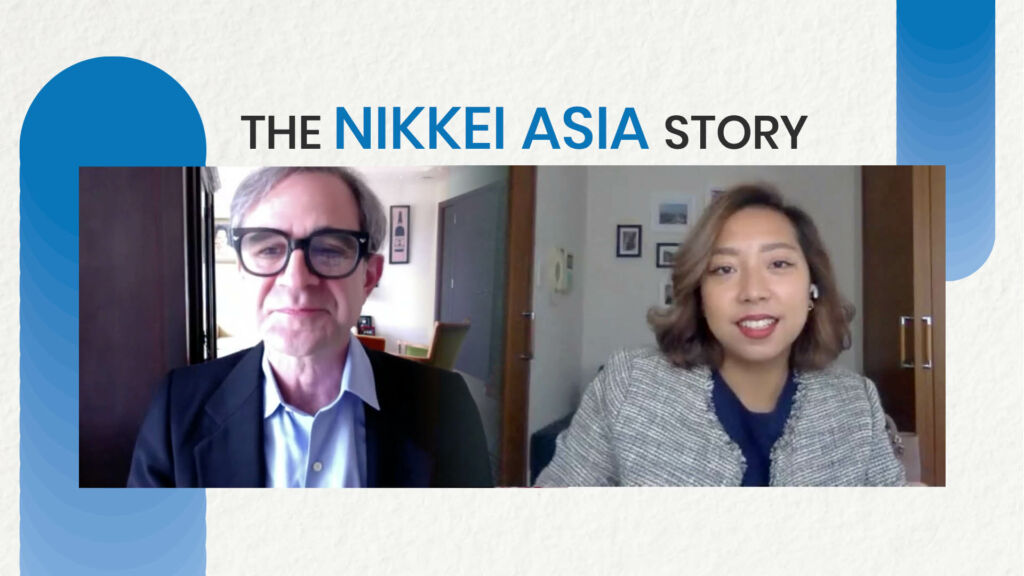Member? Please login
The Nikkei Asia story

Written by Sterling Content
May 7, 2021
Past Event Round Ups
With its acquisition of The Financial Times from Pearson plc in 2015, Nikkei, Inc. became the world’s largest business media group by number of subscribers. At the time, the Japanese organisation’s flagship publication, The Nikkei, and the FT had a combined circulation of some 3 million, more than double that of The Wall Street Journal.
On April 22, the British Chamber of Commerce in Japan hosted a webinar to ask Chris Grimes, executive editor at Nikkei Asia, and Francesca Regalado, staff writer at Nikkei Asia, about the acquisition and the evolution of Nikkei Asia, Nikkei’s flagship English-language publication launched in 2013.
Nikkei Asia
Japan’s largest financial newspaper, The Nikkei, has more than 100 years of history but Nikkei’s English-language news reporting is much more recent.
The roots of Nikkei Asia, said Grimes, are in The Nikkei Weekly, a now defunct publication first published as The Japan Economic Journal in 1963. The weekly published English language translations of stories from The Nikkei, mostly on business and technology. In 2011, an iPad edition was released, followed by a print magazine. The next step was the introduction of original reporting that was not being translated. The idea, said Grimes, was “to give the world an independent English language publication, produced in Asia by Asians.”
Today, the publication has a core of Japanese reporters who are writing in English, as well as reporters from Indonesia, the Philippines, Hong Kong and China. It makes for a unique mix of voices that are “different from what you would get from foreign correspondents writing for their home market,” he added.
The approach is winning fans. Both daily readership and paid subscriptions are growing—not an easy task when there is so much free content available online. Grimes attributes the rise in subscriptions to Nikkei Asia’s affordability and reputation as a “trusted information source,” which can be hard to find in some developing nations.
Nikkei and the FT
According to Grimes, the motivation behind Nikkei’s acquisition of the FT was to tap the London-based broadsheet’s expertise in “building digital-first subscriptions.” A few years before, the FT had made “a radical shift” from working around its print schedule to publishing stories according to when readers were online. Nikkei hoped the FT team could help it “midwife” its own “digital transition” to a digital-first model.
At first, fact-finding missions were one way, from Tokyo to London, but soon staff from the FT were coming to The Nikkei, too. They spent most of their time at Nikkei Asian Review, which Nikkei hoped could become “a laboratory” for the group’s bigger transition into digital publishing. In time, The Nikkei became digital-first, with a strong subscription model in addition to the printed newspaper.
Despite the information sharing, the London- and Tokyo-based newspapers retain editorial independence. And Grimes says readers will notice stylistic differences between the FT and Nikkei Asia too.
“FT readers are paying to read some analysis and deciphering of what is happening. The Nikkei likes to give the news in a very straight way. When we get a translation of a Nikkei news piece, we need context—a what-it-all-means paragraph—otherwise it is only going to make sense to the people in a narrow business,” he said.
Covering Asia
As Asia is the largest and most diverse continent, the panellists were asked to consider how Nikkei Asia can be relevant to its entire population.
Regalado said she often thinks of how to make topics interesting to friends and relatives in her native Philippines, where readership of Nikkei Asia is growing fastest alongside Thailand.
“We can have a tendency to be too hyper local,” she said, pointing out that the Olympics story is about not only Japan, but also business and international relations, hence the need to think “out of the box” when writing about Japan-centric topics.
Grimes noted the uptick in readership in other parts of Asia, too, including Singapore, Hong Kong, Malaysia and even Myanmar—despite difficulty accessing the Internet there. As the paper is ramping up coverage of start-ups and tech in southeast Asia, he often considers what a venture capitalist in Jakarta or Singapore might want to read.
The growing role of Asia in global affairs is also attracting readership from outside the continent. Coverage of geopolitical stories such as tech supply chains or the creation of the Quad (the strategic dialogue between the United States, Japan, Australia and India), for example, are amassing readers in Washington and other parts of the United States as well as Europe.
“Big stories cross borders,” he said, citing Nikkei Asia’s coverage of air pollution in Asia, which was possible because of the publication’s extensive network across the continent.
“Everyone is so interested in Asia, even friends in DC and New York because they want to know what is going on in this very important region,” added Regalado. “We don’t have to stretch ourselves to make Asia relevant to the US or Europe.”
Cultural differences
As the first non-Japanese reporter to join Nikkei Asia’s Tokyo staff, in 2019, Regalado shared her experience of transitioning to a Japanese work style. She described collaborating on stories with her new colleagues as “a sharp learning curve” due to their contrasting approach to interviews and writing. Her interview technique was considered too direct and aggressive; she found theirs to be too slow. Compared to her experience on Capitol Hill in Washington, she found it more difficult to speak with Japanese officials and bureaucrats.
“I wanted to defer to [my new colleagues] as local experts but also had my own idea of how stories should be written coming from an American journalism background,” she said. In the past two years, though, Regalado and her colleagues have come to learn from each other. And, ultimately, there are both Japanese and non-Japanese editors with various perspectives to ensure what is published has “a fair, balanced voice,” she added.
Now and the future
The pandemic has brought Nikkei Asia both challenges and opportunities. Reporters are working from home, communicating on Slack and visiting the office regularly. While it doesn’t affect productivity, it has eliminated water cooler talk that once fostered story ideas and limited contact with new or existing sources. Meanwhile, it has also pushed the publication to do new things, according to Grimes, including a live, free 24-hour blog on COVID-19.
Looking ahead, the newspaper aims to expand, both geographically by increasing its number of bureaus, particularly in “frontier places,” and in its coverage. Investment is underway in data journalism and investigative journalism, and plans are ongoing to boost annual subscriptions to make the publication a “commercially viable product.”
“Nikkei invests long-term,” said Grimes, “but Nikkei Asia needs to stand on its own.”







